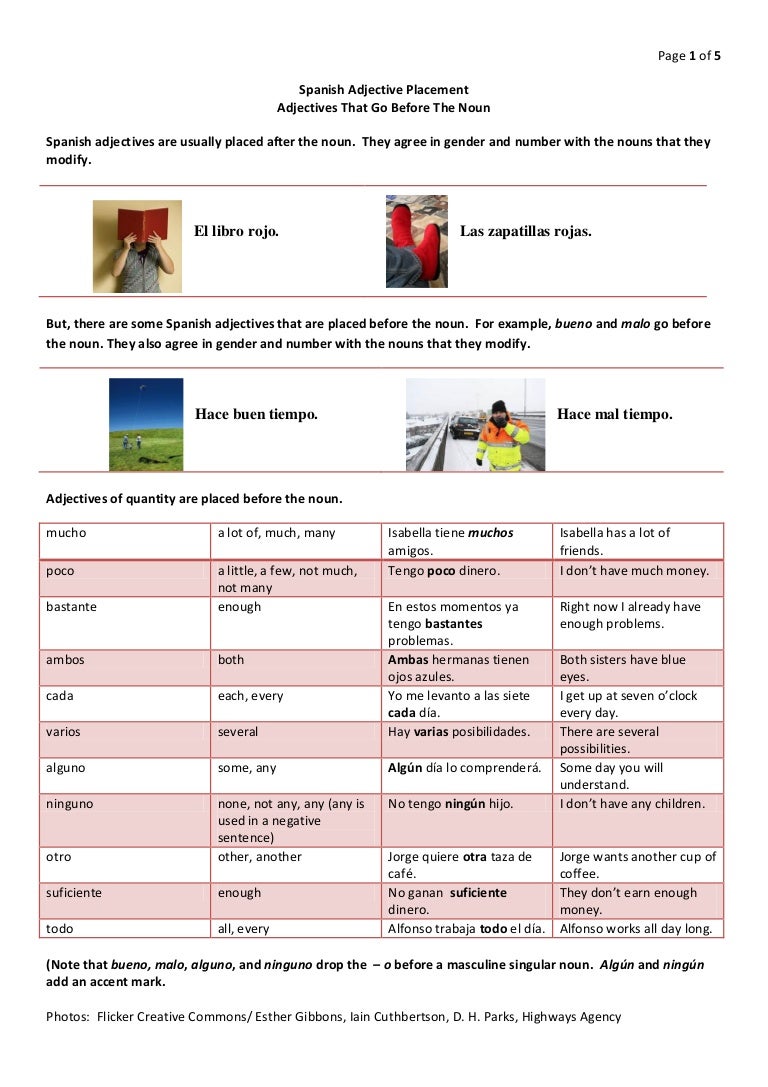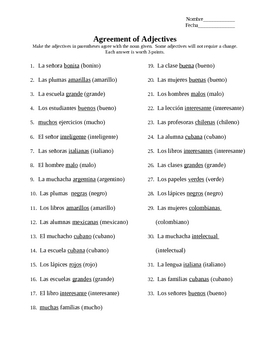How to make adjectives agree with nouns in spanish


Nuevo New Nuevo means new. Like viejo, its meaning changes subtly depending on the word order. While bajo is used when talking about height, corto is used for distances. Largo Long Watch out — this word is a false cognate. This adjective means bored — or it can mean boring, depending on whether you use ser or estar. This adjective uses estar, not ser. Estar is supposed to be used for temporary states, but if you ask me, being dead is pretty permanent! A good way to how to make adjectives agree with nouns in spanish it is to note that both vivo and muerto use the same verb — and vivo alive is definitely a temporary state, so it uses estar.
Meaning muerto does too. Here's how the rule is applied in various cases: Words Ending in an Unstressed Vowel When the word ends in a vowel without an accent, simply add the letter s.

In standard or formal writing, simply add the letters es. Words Ending in a Consonant As is common in English, nouns ending in a consonant are made plural by adding es.
What is an adjective?
Words Ending in S Preceded by an Unstressed Vowel The plural form is the same as the singular form for nouns ending in an unstressed vowel followed by s. It is also very common to simply add an s to make plural words foreign regardless of what the originating language does. Unlike English, in Spanish even inanimate nouns are classified as masculine or feminine. You can usually tell whether a noun is masculine or feminine by its ending.

Nouns ending in -ente can be masculine or feminine: gerente, cliente, dirigente. Nouns ending in -ante can be masculine or feminine: how to make adjectives agree with nouns in spanish, agente, dibujante. Singular and Plural Nouns in Spanish Most nouns in Spanish are either singular one or plural several. The plural of nouns that end in a vowel -a, -e, -i, -o, -u is usually formed by adding an -s. Did you know there are words in Spanish that can magically transform into a different part of speech? This post will teach you how to take a Spanish adjective, do some hocus-pocus and transform it into a noun. OK, maybe it is not magic. But thanks to a couple of little helpers, you can do it easily and effortlessly, nonetheless. Download: This blog post is available as a convenient and portable PDF that you can take anywhere. Click here to get a copy. Download The Difference Between Adjectives and Nouns The main difference between an adjective and a noun is its function and usage in a sentence.
An adjective is a word that describes or modifies a noun. Gender and Number in Spanish Nouns and Adjectives Spanish has two genders masculine and feminine and two amount indicators singular and plural. To activate gift card australia and nouns have a gender and how to make adjectives agree with nouns in spanish number in Spanish: el perro negro the black dog — masculine singular la mesa grande the big table — feminine singular los perros negros the black dogs — masculine plural las mesas grandes the big tables — feminine plural As you can see, while adjectives are invariable in English, they do change in Spanish.
The rule is very simple, though: Adjectives and the nouns they modify must agree in gender and number. There are many instances where you can change an adjective into a noun, and that is what this click is about. Transform Adjectives into Nouns in Spanish with 5 Magical Techniques Nouns are nouns and link are adjectives, but adjectives love transforming themselves and becoming nouns. You can find plenty of examples of this in samples of everyday Spanish speech on FluentU.
Regular past participles end in ‘-ado’ or ‘-ido’
![[BKEYWORD-0-3] How to how to make adjectives agree with nouns in spanish adjectives agree with nouns in spanish](http://lamberriprofe.weebly.com/uploads/1/4/2/1/14212157/3511519_orig.jpg)
How to make adjectives agree with nouns in spanish Video
Noun- Adjective Agreement in SpanishThe ideal: How to make adjectives agree with nouns in spanish
| Delivery restaurants near me cheap | Most past participles can be used as adjectives. Like other adjectives, they agree in gender and number with the nouns that they modify. La puerta está cerrada. The door is closed. Las puertas están cerradas. The doors are closed.
El restaurante está abierto. The restaurant is open. Los restaurantes están abiertos. The restaurants are open. Spanish Grammar in Context is a unique website that provides detailed grammar explanations and examples of the Spanish language with accompanying practice questions. Unlike traditional reference grammars, each topic is explained using authentic video examples. These examples come from the Spanish in Texas project, which profiles Spanish as it is spoken throughout Texas today. Dec 25, · O Adjectives. Adjectives that end in –o in the masculine singular form make up the majority of adjectives in Spanish. The -o may change to –a, -as, or-os, depending on the gender and number of the noun it is modifying. For example: Masculine singular: Tengo un gato negro. Spanish Describing Words Require Adjective AgreementI have a black cat. Feminine singular: Tengo una falda negra. I have a black skirt. |
| How to make french fries without deep fryer | Nov 18, · As adjectives, they agree with the nouns they describe in both number and gender; plurals have an s added, and in the feminine form the final o is changed to a. Because of differences in which participles can be used as adjectives, the Spanish participles can't always be translated directly to English as an adjective. Spanish Grammar in Context is a unique website that provides detailed grammar explanations and examples of the Spanish language with accompanying practice questions.IrregularsUnlike traditional reference grammars, each topic is explained using authentic video examples. These examples come from the Spanish in Texas project, which profiles Spanish as it is spoken throughout Texas today. Dec 25, · O Adjectives.  Adjectives that end in –o in the masculine singular form make up the majority of adjectives in Spanish. The -o may change to –a, -as, or-os, depending on the gender and number of the noun it is modifying. For example: Masculine singular: Tengo un gato negro. I have a black cat. Feminine singular: Tengo una falda negra. I have a black skirt. |
| How to make adjectives agree with nouns in spanish | 603 |
| How to make adjectives agree with nouns in spanish | 76 |
How to make adjectives agree with nouns in spanish - consider
English: The capable workers. In reality, this last rule is only important for written Spanish. How to deal with Spanish adjective order Now for the toughest part of Spanish adjectives, apart from the exceptions—the order! Sometimes the order is dictated by the noun, sometimes by the adjective, sometimes by the context and sometimes by convention. I have broken down the rules in the way that I believe make sense, are easy to understand, are wide-reaching in their application and can be remembered. So when it comes to order, https://nda.or.ug/wp-content/review/sports/how-to-use-apple-gift-card-for-netflix.php can categorise Spanish adjectives as follows: Must go how to make adjectives agree with nouns in spanish the noun.Must go before the noun. Can go in either position without changing meaning. Can go in either position but change meaning with position. The smallest group of adjectives is group 3.
What level do Yokais evolve at? - Yo-kai Aradrama Message